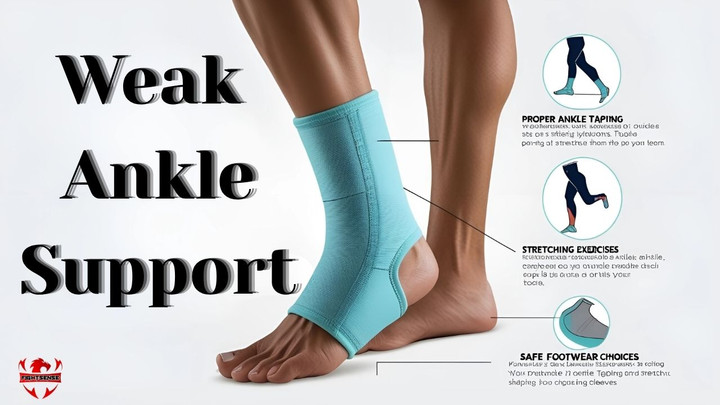Effective Weak Ankle Support Tips for Active Recovery
28th Jul 2025
It can be hard to manage with weak ankles, whether you're recuperating from an injury or have chronic instability. Weak ankle support is important to avoid getting hurt again and to stay mobile. Support that is perfect for you can help you feel better, avoid strain, and speed up your recuperation.
In this article, we'll talk about how to help weak ankles when you run and give you some advice on how to help a twisted ankle. You may get your strength back, avoid more injury, and continue active without stress if you use the appropriate tactics.
Keynotes
- Weak ankle support reduces pain and improves mobility.
- Use proper ankle support during physical activities like running.
- Choose a breathable, adjustable sleeve for maximum comfort.
- Gradually strengthen your ankles for long-term stability.
- Always consult a doctor if you experience severe symptoms.
What is Weak Ankle Support?
Weak ankle support is any kind of brace, sleeve, or other protection that is meant to keep the ankle joint stable and safe. Weak ankles need particular care when you do physical activities, whether it's because of past injuries or just being unstable. Ankle support's job is to keep the right amount of pressure on the ankle so that it doesn't move too much, which lowers the risk of sprains and other ailments.
Here’s how it helps:
- Provides stability to weak or injured ankles
- Reduces swelling and inflammation
- Minimizes risk of further damage
- Improves mobility and confidence during movement
How to Support Weak Ankles When Running?
It can be hard to run if you have weak ankles. People who are healing from an injury or who have persistent ankle instability sometimes worry about how to maintain weak ankles while jogging. If you use the correct support techniques, you can keep running safely.
Here’s what you can do:
- Choose the right ankle brace or sleeve: A breathable, supportive ankle sleeve can help stabilize your ankle without restricting movement. Look for adjustable sleeves for a custom fit.
- Warm-up and stretch properly: Before hitting the road, take the time to warm up and stretch to improve flexibility and prepare your muscles.
- Gradually increase distance: If you're recovering from an injury, avoid pushing your limits too quickly. Start with shorter runs and gradually build your distance.
- Strengthen your ankle: Incorporate ankle strengthening exercises to build stability over time, such as heel raises and ankle rotations.
- Consider cushioned insoles: Adding cushioned insoles to your shoes can provide additional support and reduce shock during running.
Twisted Ankle Support: How to Manage the Injury
A twisted ankle support is crucial if you’ve suffered an ankle sprain or twist. This common injury happens when the ligaments around the ankle joint are overstretched, resulting in swelling, pain, and limited mobility. To recover effectively, you need the right support system.
Here’s how to manage a twisted ankle:
- Apply compression: Use an ankle support sleeve or wrap that provides compression to reduce swelling and improve blood flow.
- Elevate the ankle: Rest the ankle above heart level to reduce fluid buildup and swelling.
- Use ice therapy: Apply ice to the twisted ankle for 15-20 minutes every couple of hours during the first 48 hours.
- Rest and limit movement: Avoid putting weight on the injured ankle until swelling and pain subside.
- Gradual reintroduction to activity: Once the pain decreases, gently start moving the ankle and using it in low-impact activities.
Choosing the Right Weak Ankle Support
What you need the weak ankle support for will determine which one is best for you. It could be to heal after a sprain, deal with instability, or avoid being hurt. FightSene's compression sleeves are adjustable and breathable, so they give you flexible, strong support. They make sure you have a comfortable fit for everyday activities like walking, running, or standing, as well as for rehabilitation.
Here’s what to look for:
- Adjustability: Choose a support that’s adjustable for a personalized fit and comfort level.
- Breathability: Make sure the material is breathable to prevent discomfort from excessive sweating.
- Level of support: Consider how much support you need. For mild issues, a compression sleeve may be sufficient; for more severe instability, a brace with straps and additional support might be necessary.
- Ease of use: Select a support that’s easy to wear during physical activities or throughout the day without hindering movement.
How to Use Ankle Support and Wear Duration
Proper use of ankle support is key for recovery and injury prevention. Here’s how to use it:
- Choose the Right Support: Select a compression sleeve for mild instability or a brace for more severe issues.
- Wear During Activity: Use it during running, walking, or standing, especially if prone to instability.
- During Recovery: Wear throughout the day to reduce swelling and promote healing.
- Night Use: Wear at night if advised, or remove for rest.
- Gradual Reduction: As healing progresses, reduce wear based on comfort.
Conclusion
Weak ankle support is important for keeping you from being hurt again and helping you heal. The correct support system can make a big impact, whether you're jogging, walking, or healing from a sprained ankle.
You can keep your ankles healthy and stay active by learning how to support weak ankles while running and choose the correct equipment for the job. Keep in mind to use the right methods for healing and get medical help if you need it.
Disclaimer
This blog is for informational purposes only and should not be considered a substitute for professional medical advice. Always consult a healthcare provider before starting any new treatment for ankle injuries or conditions.

